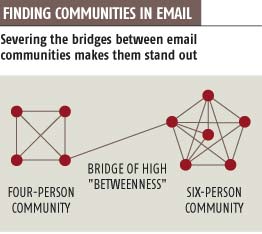
« PREVIOUS ENTRY
Hark! From afar, distant voices with fell news
NEXT ENTRY »
Self promo: My article on Internet war coverage

Dig this: A group of Hewlett Packard researchers studied 200,000 emails sent on their company’s internal network. They analyzed them to see how they clustered, and discovered that it’s pretty easy to figure out what little subgroups exist within a larger organization. As a story in the New Scientist puts it:
To pick them out, the researchers used a computer algorithm that looks for the critical links that form bridges between separate groups - what the team calls links with high “betweenness”. By severing these links one by one, the algorithm gradually isolates people into different communities of groups who are emailing each other. …
The technique revealed 66 communities at the lab. And when the researchers compared the community members with the company organisation charts, they found that 49 of them contained people who all worked in the same department. In most of the others, the people were collaborating on a project.
Simple enough — when you look inside an organization, you’ll find a bunch of groups. Where it gets interesting is when you look outside, into the full Internet. Would it be possible to examine email movement to figure out who “knows” who? Or, more importantly, who’s the ringleader of a group?
In a second investigation, the team plotted the same network of emails using a standard algorithm that, in effect, tries to arrange it in the least tangled way possible. This showed that the managers, including the director, tended to cluster in the middle. “This approach puts in the middle the people who have the most diverse range of contacts in the organisation - and these tend to be the leaders,” says Tyler.
An interesting way to hunt for the leader of a terrorist cell, to be sure. But also a superb way to run a dragnet on ever more totally innocent people, which is the strange direction our security apparatuses seem to be going these days. I can only imagine how much the Carnivore guys are slavering over these sorts of techniques. The HP guys themselves seem fairly agnostic as to how one could use this technique; they’re just scientists, and this is good science — you can download a PDF of their paper about the experiment here.
(Thanks to Coder Log for pointing this one out!)
I'm Clive Thompson, the author of Smarter Than You Think: How Technology is Changing Our Minds for the Better (Penguin Press). You can order the book now at Amazon, Barnes and Noble, Powells, Indiebound, or through your local bookstore! I'm also a contributing writer for the New York Times Magazine and a columnist for Wired magazine. Email is here or ping me via the antiquated form of AOL IM (pomeranian99).

ECHO
Erik Weissengruber
Vespaboy
Terri Senft
Tom Igoe
El Rey Del Art
Morgan Noel
Maura Johnston
Cori Eckert
Heather Gold
Andrew Hearst
Chris Allbritton
Bret Dawson
Michele Tepper
Sharyn November
Gail Jaitin
Barnaby Marshall
Frankly, I'd Rather Not
The Shifted Librarian
Ryan Bigge
Nick Denton
Howard Sherman's Nuggets
Serial Deviant
Ellen McDermott
Jeff Liu
Marc Kelsey
Chris Shieh
Iron Monkey
Diversions
Rob Toole
Donut Rock City
Ross Judson
Idle Words
J-Walk Blog
The Antic Muse
Tribblescape
Little Things
Jeff Heer
Abstract Dynamics
Snark Market
Plastic Bag
Sensory Impact
Incoming Signals
MemeFirst
MemoryCard
Majikthise
Ludonauts
Boing Boing
Slashdot
Atrios
Smart Mobs
Plastic
Ludology.org
The Feature
Gizmodo
game girl
Mindjack
Techdirt Wireless News
Corante Gaming blog
Corante Social Software blog
ECHO
SciTech Daily
Arts and Letters Daily
Textually.org
BlogPulse
Robots.net
Alan Reiter's Wireless Data Weblog
Brad DeLong
Viral Marketing Blog
Gameblogs
Slashdot Games